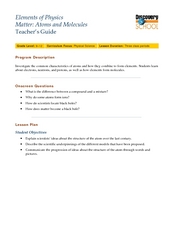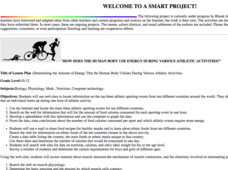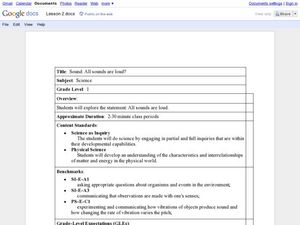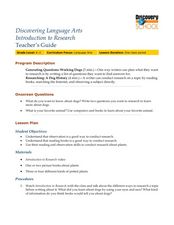Curated OER
Coral Reef Lesson Plan Caution: Do Not Bleach!
High schoolers explain five ways that coral reefs benefit humans and identify three threats to the reefs. They investigate the phenomenon of "coral bleaching" while examining ways to reduce threats to coral reefs.
Curated OER
Innovations in Obstetrics and Pediatrics
Students study the history in obstetrics and pediatrics. In this investigative lesson plan students research and present information about winners of the Nobel Prize.
Curated OER
Matter: Atoms and Molecules
Students investigate how information about the atom has been determined. In this atomic structure instructional activity, students draw what they think an atom looks like. They conduct Internet research about the types of atomic models...
Curated OER
Comparing Temperature, Pressure, and Humidity
Students investigate data on temperature, pressure, and humidity by downloading information from the ARM Website. Working in groups, they discover how weather impacts life in each of the ARM sites. They record weather data in their...
Curated OER
Mexican-American Life in Texas
Sixth graders examine the development of cotton farms in Texas and the use of Mexican-Americans as a labor force. They examine pictures of life on cotton farms and draw pictures of themselves performing one of their own daily chores. ...
Curated OER
ZIPPLY Delicious Ice Cream
Second graders explore states of matter when they change a liquid to a solid. Working students make ice cream in a zip-lock bag.
Curated OER
Animals: Graphic Organizer
Second graders research information on the animal of their choice using the James E. Gerholt animal series books. They create a graphic organizer (concept web) using Kid Pix Deluxe 3 software, display information on screen, and create a...
Curated OER
Familiarizing Students with the 5 Food Groups
Students review a variety of foods and classify them into food groups. They identify the benefits of each food group to our bodies and consider how deficiencies of these groups affect humans. They sort pictures, view a video and write...
Project SMART
Dinosaur Trek
Second graders investigate dinosaurs. They explore various websites, submit questions to a paleontologist online, construct cut and paste model dinosaur skeletons, develop a graph to compare dinosaurs, and label pictures from online...
University of Rhode Island
How Does the Human Body Use Energy during Various Athletic Activities?
Students investigate how much energy is used during different athletic activities. They conduct Internet research to obtain information on the top three athletic sporting events from around the world, and calculate the calories burned...
Curated OER
GeoHunt
Students describe the difference between geological resources and othe natural resources. They list the rocks, minerals, and fossil fuels that are found in Illinois and their uses. They identify ways to conserve natural resources.
Curated OER
Amphibians-Frog Dissection
Students compare the anatomy of a fish to an amphibian and that of an amphibian (frog) to a human. They complete a virtual frog dissection to gain some experience prior to the real dissection.
Curated OER
Forces and Energy Study Guide
Sixth graders use prior knowledge to create a tri-fold study guide using Microsoft Publisher (if available). They include real world examples that show balanced and unbalanced forces, kinetic and potential energy, and vocabulary. The...
Curated OER
Best Practices of Technology Intergration
Students compete in a Lego Robot Competition. In this after school lesson, students design and compete in the Lego Robot Competition. This lesson includes time-lines and guidelines for an after-school club.
Curated OER
A State of Obesity
Students compare obesity trends between states. In this health studies lesson plan, students conduct research to compare and contrast obesity trends from state to state. Students view a PowerPoint presentation to determine...
Curated OER
Sound: Are All Sounds Loud?
First graders explore physics by utilizing education software. In this sound properties activity, 1st graders discuss the different sounds associated with different materials and perform an object dropping experiment in class....
Curated OER
Weather Awareness
Second graders investigate weather. In this weather lesson, 2nd graders discover how to read a temperature gauge, keep track of the weather, and find out how the weather affects their day. They work individually and in partners to make...
Curated OER
Interdisciplinary Task: Weather
Students design a chart to use to record the weather for five days. They then build an anemometer to record wind speed and discover why they are used for this purpose.
Curated OER
Forms of Energy
Students, working in expert groups, study a form of energy. They plan a slide show presentation using pictures, clip art, and student taken digital pictures that show the energy type they have become experts in. They use a planning sheet...
Curated OER
Sharing Dragons
Students investigate the contribution of Chinese people to celebrations in Australia and explore why they have played such a prominent role. They suggest how a group from their local area, if they had moved to live in another country,...
Curated OER
Dinosaurs - Creatures Of The Past
Students use the internet to search for information and pictures of dinosaurs. They distinguish between meat-eating and plant-eating dinosaurs and explore theories about the extinction of dinosaurs.
Curated OER
Discovering Language Arts: Introduction to Research
Students research plants. For this researching lesson, students watch a video about the different ways to research a topic before writing about it. Students use the information gathered in this video to learn more about plants. Students...
Curated OER
Analyzing Motion of a Tossed Ball
Students investigate the parameters involved with launching a basketball at an angle. In this motion lesson students predict and sketch graphs that show the motion of a ball toss.
Curated OER
Impulse/Momentum Lab
Students investigate the relationship between force and momentum using motion detectors and sensors. In this physics lesson, students graph experimental results. They calculate impulse using the area under the graph.























